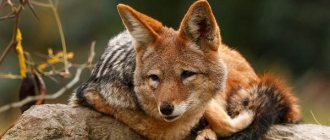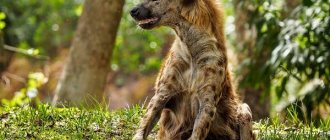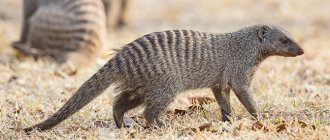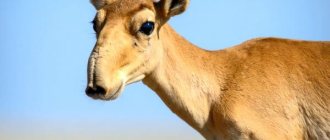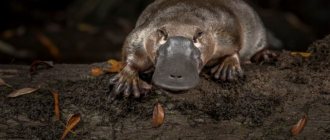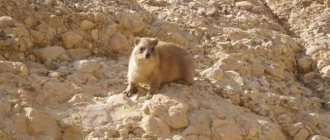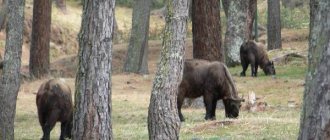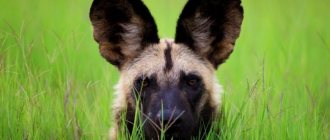- Wild animals
- >>
- Mammals
Many people associate jackal This animal represents cowardice, deceit, and sycophancy among different nations. One has only to remember the jackal named Tabaqui from Kipling’s well-known work, it immediately becomes clear that the image of this animal is not at all positive. But not everyone has a negative attitude towards jackals; the ancient Egyptians treated the beast very respectfully, depicting the god Anubis with a jackal’s head. It will be interesting to figure out what kind of predator this predator really is?
Origin of the species and description
Photo: Jackal
The jackal is a predatory mammal, a representative of the canine family, it belongs to the genus of wolves. When you look at this slightly awkward animal, you get the impression that it is something between a wolf and an ordinary yard dog. To describe a jackal, you need to pay attention to the varieties of this animal, each of which has its own distinctive features and characteristics:
- The appearance of the common jackal resembles a slightly reduced wolf. The length of its body, not counting the tail, reaches 80 cm, and its height – up to 50. The weight of an adult individual on average reaches 8 – 10 kg. The predominant tone of the coat is gray, but with light red, yellowish and fawn streaks. The back and sides are darker, may be black, and the belly and inside of the neck are usually light gray or yellowish.
- The striped jackal got its name due to the presence of light stripes on its sides. The predator's back is brownish-gray, and its tail is dark with a white tip. The jackal's muzzle is slightly shortened and wide compared to other species. This jackal has the strongest and largest fangs. There are special glands on the face and anal area that secrete a fragrant secretion;
- The black-backed jackal is very similar to the striped jackal and has red-gray fur. On the back the fur is of a darker shade; it forms something like a black saddle cloth, descending closer to the base of the tail. The weight of these animals is slightly greater than that of ordinary jackals (about 13 kg), although the body dimensions are approximately the same.
- The Ethiopian jackal is quite large when compared with other species. The mass of a male individual is about 16 kg, and the height of the animal is 60 cm. The predator has long legs and an elongated muzzle. The fur coat has a red, slightly brownish tint, which matches the light chest, inside of the legs and neck.
Not long ago, scientists conducted research in the field of genetics, as a result of which it was found that the Ethiopian jackal descended from an ordinary wolf. And their closest relatives, the striped and black-backed jackals, separated from wild dogs living in Africa and Eurasia, and wolves about seven million years ago.
Appearance and features
Photo: Jackal animal
Naturally, all types of jackals have common, unique features that distinguish them from other animals. The head of predators is not very large (the skull is about 19 cm long), has the shape of a triangle and a sharp muzzle. Jackals' ears always stand up, they can be seen from afar, they are quite large with slightly blunt tips. Eye color ranges from light to dark brown. The fangs of predators are impressive, sharp, but thin; they cut the skin of the caught victim like knives.
Video: Jackal
Outwardly, the jackal is similar to a coyote, a wolf, and an ordinary dog. He looks a little awkward, resembling a shabby, emaciated wolf or a homeless stray dog. The jackal's legs are thin and long, and its body is strong, covered with short, bristly fur. The massive fluffy tail is always pointed downwards. The coloring of different species is also varied, it depends on the area where the jackal has permanent residence.
The following tones predominate in the color of the fur coat:
- Light grey;
- Reddish;
- Brownish-red;
- Yellowish-gray;
- Dark grey.
Jackals moult a couple of times a year – in autumn and spring. Its duration is about two weeks. It has been noticed that in the summer the fur of animals is stiffer and shorter, and its color appears more red. On the abdomen, chest, chin and inner parts of the limbs, the fur is always light in color with some yellowish tints.
Another feature of jackals is the different number of toes on their paws. There are five of them on the forelimbs, and four on the hind limbs. Each finger has a short claw. It is worth noting that the females in the jackal family are slightly smaller than the male representatives of the genus.
Where does the jackal live?
Photo: Jackal dog
Jackals are quite widespread across many territories and continents; they inhabit:
- Southeastern Europe;
- South Asia;
- Near East;
- Africa.
These animals managed to take root both in steppes and semi-deserts, in forests with high humidity, in mountainous areas; animals can also be found near human settlements. Sometimes jackals migrate, looking for new places for food, thereby choosing new regions for permanent habitat. Recently, their distribution area has been moving further north. And where jackals were not found before, now they have taken root quite successfully.
As for our country, jackals used to be found in the forests of the Black Sea and Caspian coasts and were considered quite rare animals. Zoologists noticed that in the twenty-first century their number increased greatly in the Krasnodar Territory, then jackals were spotted on the Crimean Peninsula.
In 2002, they appeared in the Rostov region, and they settled there so successfully that by 2015 there were a lot of them. They chose the Don delta, settling in dense reeds. The local government even had to offer a reward for shooting these predators in order to at least slightly reduce their increased numbers.
Jackals give their preference to places with impassable thickets of trees, tall grasses, reeds, and bushes. They make dens right in the thick of the bushes. Only in semi-desert open areas do they dig small burrows. Those individuals that live in mountain ranges try not to rise above one kilometer. The proximity of a body of water is a tangible plus for the jackal, but this condition is not mandatory.
An interesting fact is that jackals are not at all afraid of severe frosts; they normally tolerate temperatures of 35 degrees below zero, but moving through snowdrifts is a real problem for them. Animals try to move along paths that were laid either by people or large animals.
It is worth noting that all four species of jackals live on the African continent, spreading throughout almost the entire continent.
Communication
Territories are indirectly maintained by scent markings and vocalizations. Both members of the couple use the leg-raised urination position to mark tufts of grass, bushes and trees. The presence of the scent of both members of a pair can tell potential intruders that they are both actively residing on their territory.
Photo: Loic Poidevin
Vocalization in the form of howls is usually used to find conspecifics, indicate personal territory and demonstrate dominance. Jackals also produce "rumbling growls" and "predator barks" when potential predators, such as spotted hyenas, approach a den with cubs. The pups respond to these vocalizations by running into the den.
What does a jackal eat?
Photo: Wild jackal
The jackal menu is very varied. These predators are tireless hunters and food seekers. Animals hunt alone, sometimes uniting in pairs to drive and kill larger prey. Jackals can make high, lightning-fast jumps, thereby grabbing birds that are already taking off. Their prey can be pheasants, trouts, waterfowl, coots, and sparrows. Jackals can also commit robbery, committing predatory raids on farmsteads, where they steal turkeys, chickens, ducks, geese, lambs, and kids.
Jackals eat muskrats, nutrias, badgers, hares, and all kinds of rodents. These omnivorous predators will not refuse a variety of insects, lizards, frogs, snails and even snakes. If you are lucky, they can also feast on fish, including suloy. A plant menu is also not alien to jackals; they happily eat various fruits, vegetables, cereals, melons, feast on nuts and berries, and will not refuse rhizomes and tubers of plants. With the help of juicy melons and watermelons they quench their thirst. In extreme heat, animals move closer to the water. If the river dries up, the animals dig holes at its bottom to drink from groundwater.
Jackals are considered scavengers, but this is not entirely true. Of course, carrion and various human waste are in their diet, but much here depends on the type of animal. For example, carrion is practically absent from the menu of the striped jackal; the animal prefers freshly caught food (insects, rodents, hare meat) and various fruits. But the common jackal does not disdain carrion; it rummages through landfills in search of food; it is often accompanied by vultures to enjoy a joint meal.
The Ethiopian jackal's menu consists of 95 percent of various rodents; sometimes it manages to feast on a hare or a small antelope. Incursions by jackals into livestock pastures are extremely rare today. So, we can say with confidence that the jackal is an almost omnivorous animal.
You can't shoot without mercy
According to residents, this year the jackals have completely stopped being afraid of people and walk without fear near populated areas, enter courtyards, terrifying people.
“On the street of Promyshlennaya Stanitsa Novopokrovskaya, jackals walk as if at home. As soon as it gets dark, they rush into the courtyards to steal something tasty. A resident of N. of this street stabbed one with a pitchfork, as the predator was rushing into the yard. According to him, the animal was not afraid of humans, it behaved inappropriately, it was shaking, and foam was coming out of its mouth. We contacted the administration. They answered us: “Wait for November 1st - the hunting season will begin, then the hunters will drive away with dogs...” The question is - where? To another street? Will we wait until the jackals start attacking people? I'm not even talking about pets.
Please, dear editors, take action before trouble happens.”
A. Stryapan published this post in the “SG” group on the Odnoklassniki social network. Within a few days, 6,700 people watched it, and 54 commented. Some fearfully argue that animals need to be shot, others are trying to protect them.
What was the reason for this behavior of forest predators, why did they get so close to housing? Or maybe people themselves provoke the appearance of uninvited guests? And are they as dangerous to humans as the author of the post describes?
Features of character and lifestyle
Photo: Jackal animal
The jackal can be called a twilight predator; it leaves its lair when it gets dark to go hunting. Although the Ethiopian jackal, on the contrary, prefers to hunt in the daytime. In search of food, jackals can travel long distances, constantly on the move. These animals miraculously sense the death of any animals and rush to taste the carrion. Interestingly, before a hunting expedition, the animal emits a long howl, like a battle cry, which is picked up by all its relatives nearby.
Jackals live in married couples, having their own territory, which they constantly mark. The size of the plot can reach up to 600 hectares. Everyone who does not belong to the family is expelled from the site. Young animals can also live with their parents, helping in raising the babies, but gradually older jackals form their own family unions and go off to look for their own territories.
Zoologists know little about the character and habits of the jackal, because... the animal is very secretive and poorly studied. Jackals are distrustful of people, although it has been observed that during severe winters they move closer to human settlements.
An interesting fact is that the black-backed jackal species is more willing to make contact with people, gets used to communication and even becomes almost tamed animals and begins to trust people. The average lifespan of jackals living in the wild does not exceed 12 years, although some specimens live up to 14.
In general, in people's minds the image of a jackal is usually negative. One of the bad traits that is attributed to the jackal is cowardice. In fact, this is unfounded. The jackal is most likely not cowardly, but very cautious. In those areas where a person is friendly towards him, a jackal can even allow him near his offspring.
Unbridled curiosity and arrogance often overcome jackals. People who stayed overnight in places where jackals live saw for themselves how they steal both food and clothing items right from under their noses. These are the jackals, unique animals with many interesting character traits.
Social structure and reproduction
Photo: Jackal
All species of jackal, except the Ethiopian, are considered monogamous. Animals form a family unit for life. Both parents are very caring and sensitive; together they arrange their home and raise their offspring. Jackals either dig holes themselves or occupy the abandoned dens of foxes, badgers, aardvarks, and porcupines. Animals can use old termite mounds, large hollows, crevices, and dense thickets for housing. If jackals live in a hole, then there must be a wide nesting chamber located at a depth of about one and a half meters.
It is interesting that a young female, ready to mate for the first time, accepts the advances of several gentlemen, who sort things out among themselves through violent fights; their winner becomes her companion for life. Depending on the permanent place of registration, the mating season of the common jackal can begin either at the end of January or in February, its duration is about 28 days. At this time, you can hear the strong howling of these predators.
There is no specific time of day for mating; it can occur at any time. Sometimes a female does not get pregnant right away, so a few days after the first heat, the second begins. If pregnancy does not occur the second time, then you will have to wait until next year. The duration of the gestation period lasts on average from 57 to 70 days.
In a litter, a jackal usually has from two to four cubs, sometimes there are eight of them. Babies are born with soft fluffy fur, completely blind and weigh about 200 grams. Gradually, the color of their fur changes, redness and bristly hairs appear, and the puppies begin to see the light closer to two weeks. By this time, they also develop hearing, and by the age of one month, babies take their first steps, standing on stronger legs.
A caring mother treats her offspring with milk until approximately 2 to 3 months of age. By the age of twenty days, common jackals begin to feed their babies with regurgitated food and meat. Teething in babies begins as early as two weeks of age and lasts until almost five months. Puppies quickly gain weight; by the time they are a month old they already weigh half a kilogram, and by four months they weigh more than three.
Females become sexually mature closer to the age of one year, and males a little later. Despite this, young jackals often continue to live with their parents until they are two years old.
Habitat
The jackal is distributed throughout India and regions to the west of it - in the Near and Middle East, Central and Asia Minor; throughout sub-Saharan Africa. In Europe, it is found in Greece and the Balkans, the Caucasus, Dagestan and almost the entire Black Sea region. At the end of the 20th century. - at the beginning of the 21st century. The jackal entered Ukraine and appeared in the Donetsk, Odessa and Kherson regions of Ukraine. Throughout the entire length of its range, the jackal prefers places heavily overgrown with bushes and reed beds near water bodies. In the mountains it rises to a height of up to 2500 m, but in general it is less common in the foothills. As shelters, the jackal usually uses various natural niches and depressions, crevices among stones, sometimes holes of badgers, porcupines, foxes, and occasionally digs them on its own. Clearly visible paths usually lead to its lairs. The jackal not only does not avoid the proximity of humans, but often, on the contrary, settles near housing and then trades in waste, steals poultry on occasion, and goes out into the fields. In India and Pakistan, at night he can often be seen wandering the streets of villages and even cities. Even in the huge, 10 million-strong Delhi, jackals are frequent inhabitants of overgrown wastelands, cemeteries, littered urban forest parks, and railroad rights-of-way. With such ecological plasticity, the common jackal as a species is, of course, out of any danger.
Natural enemies of jackals
Photo: Common jackal
Jackals have a lot of enemies in the wild, because they are not a very large predator. Wolves and ordinary dogs are hostile to jackals, although the latter often coexist peacefully with them, rummaging side by side in the same landfills. Previously, when there were much more large predators such as leopards and tigers, they also caused significant damage to the jackals, although they also had benefits, because the jackals ate the remains of their meal. Now in natural conditions, competition for jackals includes foxes, hyenas, jungle cats, raccoons, and wild steppe cats.
People can also be considered enemies of jackals, because in some areas they exterminate animals, considering them pests for their cultivated plots and farmsteads. In addition, black-backed jackals are hunted for their beautiful and valuable fur, which is used to make carpets in the south of the African continent.
In addition to various predators and humans, one of the most dangerous enemies of jackals are various epidemics and diseases that claim the lives of many animals. Since the diet of many predators often includes carrion and waste, they act as carriers of rabies, transmitting the disease to many animals. In Africa, 25 percent of animals become infected with rabies from jackals.
In addition to rabies, jackals can carry distemper; they are often infected with all kinds of ticks, helminths and other parasites. Sometimes animals die due to lack of food, especially in the harsh winter. So, there are plenty of enemies and various unfavorable conditions that threaten the life of jackals in the wild.
Population and species status
Photo: Wild jackal
The distribution range of jackals is quite wide, it covers more than one continent. Due to the fact that these predators are very hardy and can adapt to different conditions, they began to spread to areas where they had not been observed before. Perhaps these migrations are associated with the search for new sources of food.
The common jackal is not in danger of extinction. In many areas its numbers are only increasing, and the habitat of this jackal species is expanding. And where the predator was considered a great rarity, it successfully bred and feels excellent. For example, here we can name Serbia, Albania and Bulgaria. Jackal hunting has been strictly prohibited in these countries since 1962, because... the animal was practically never seen, now the situation has changed and the jackal population is not in danger, which is good news.
Two deer walked...
It turns out that not only jackals walk through populated areas. So, two deer walking along the main street were noticed by Novopokrovsk residents on a September evening.
Noble animals crossed the road freely. The appearance of deer near the administration caused a heated discussion on social networks, where a photo with deer appeared. Some suggested that the beautiful animals were the property of careless owners, while others suggested that they had lost their way of migration.
0
